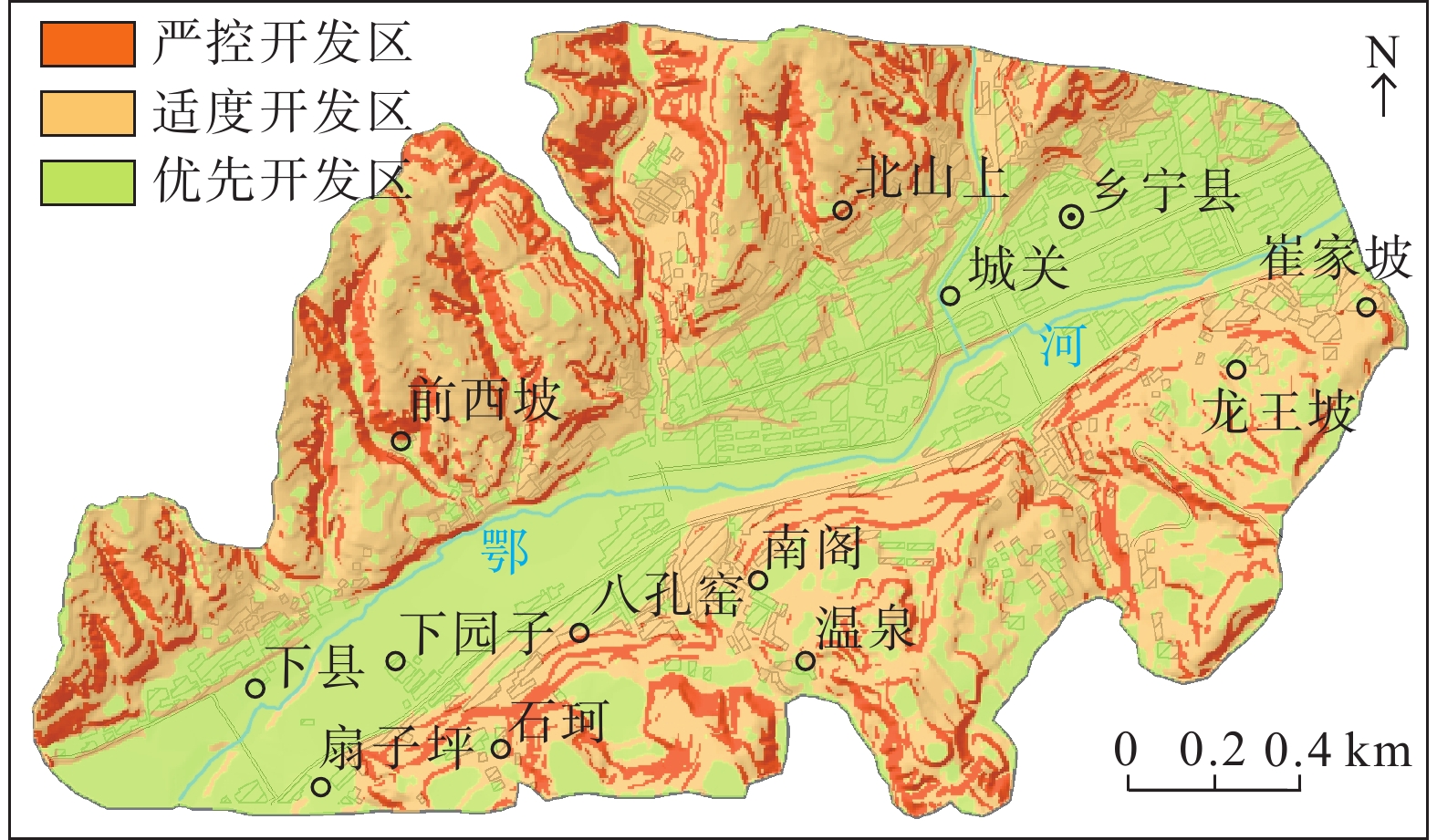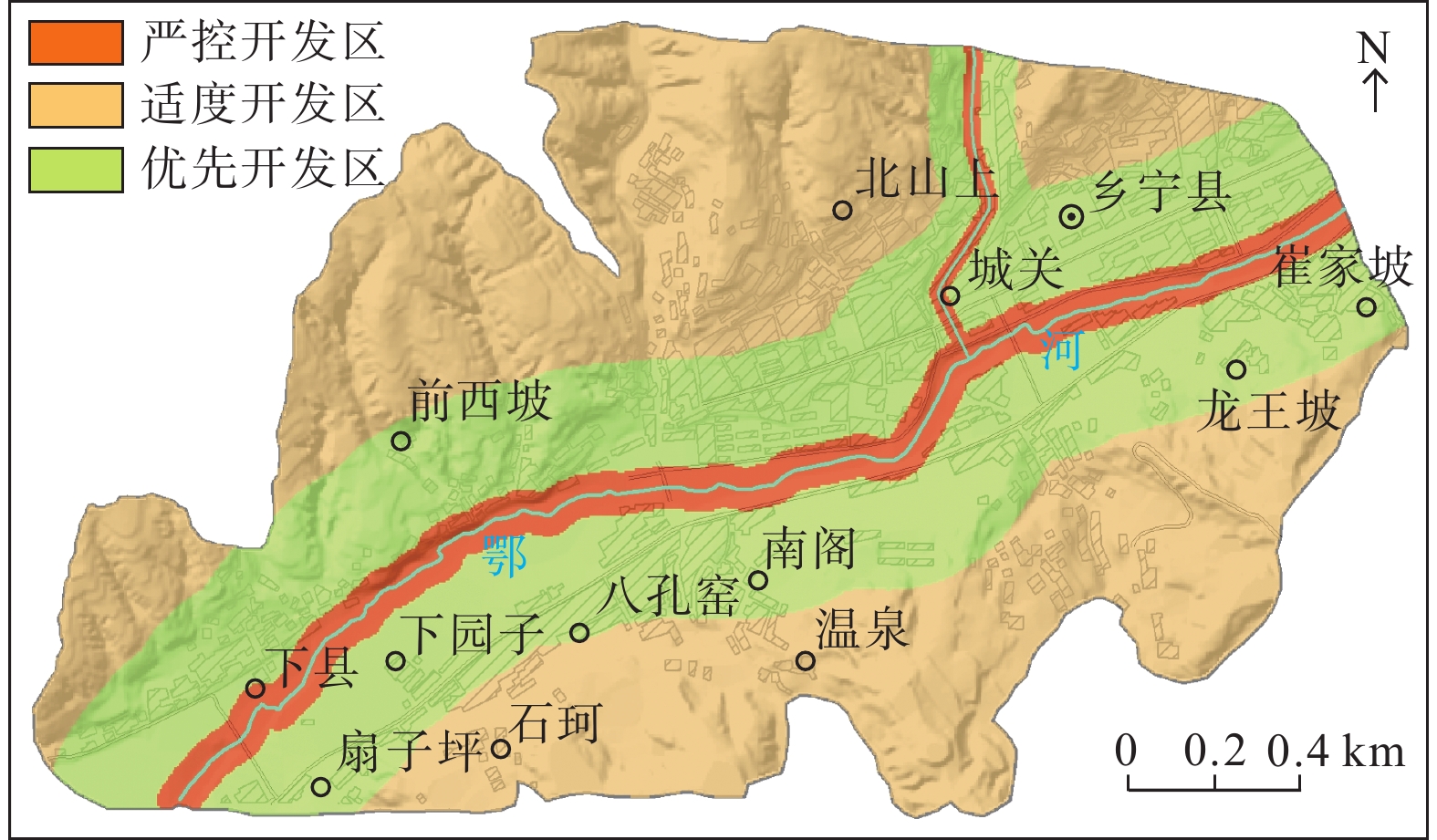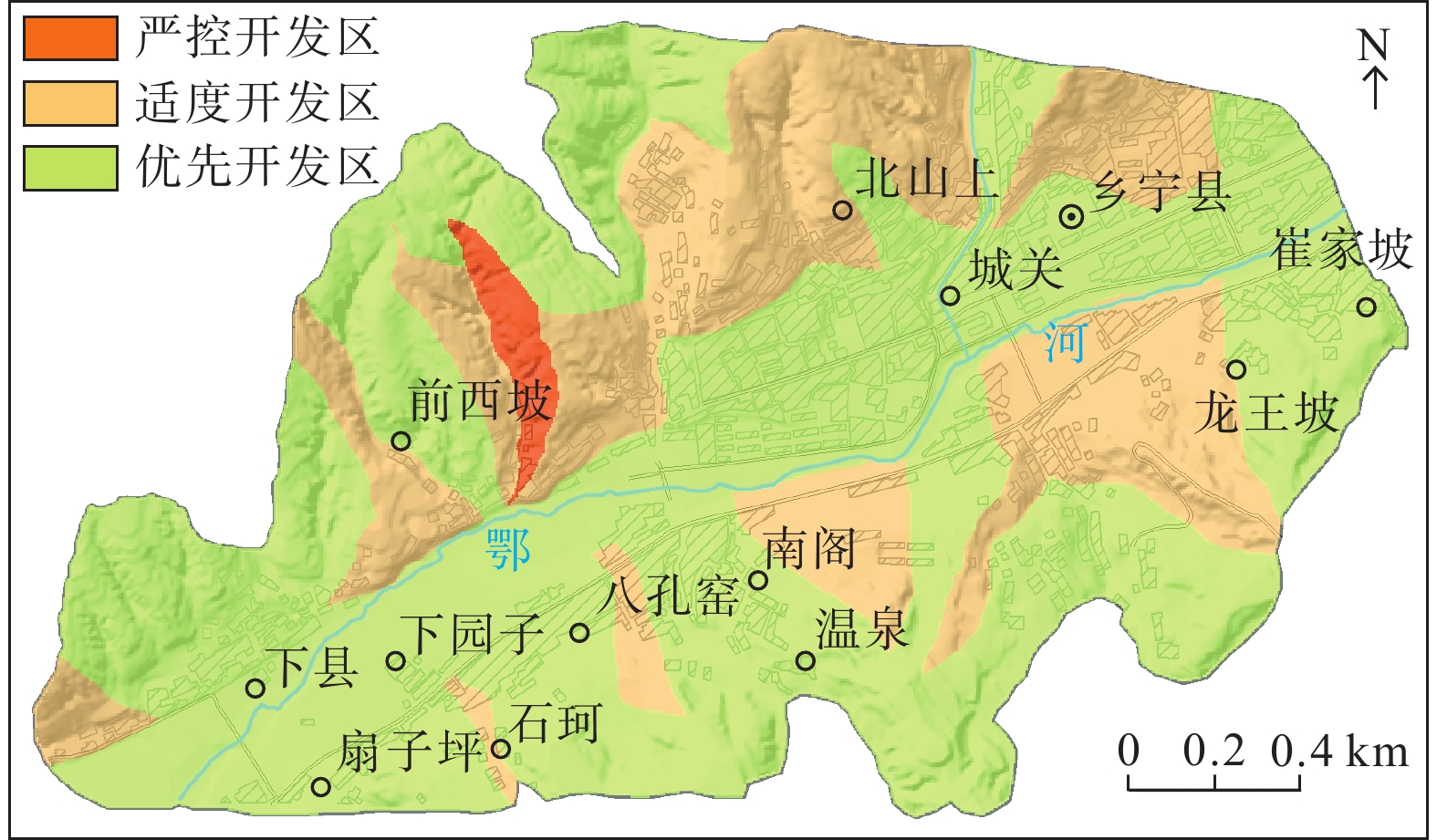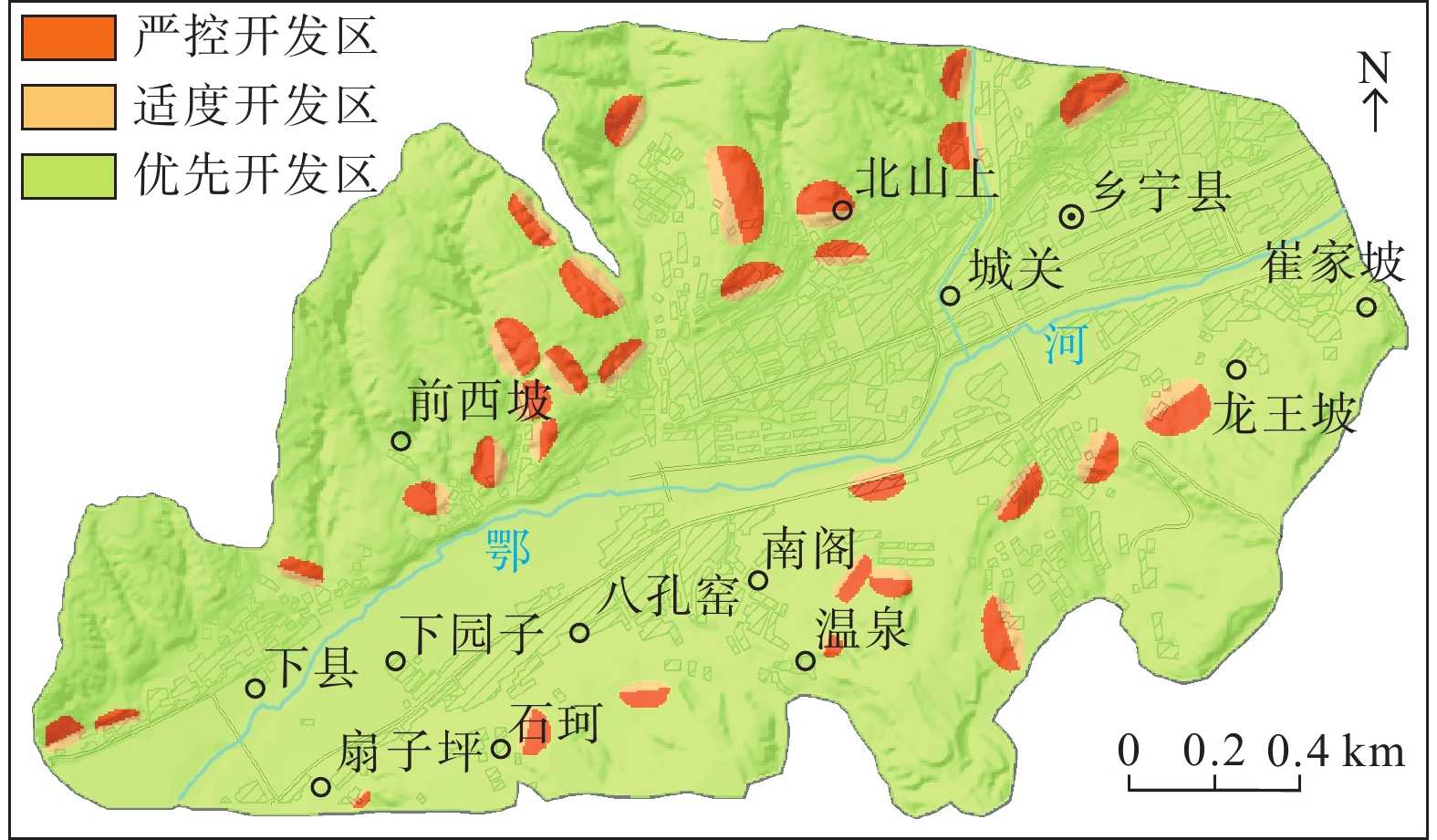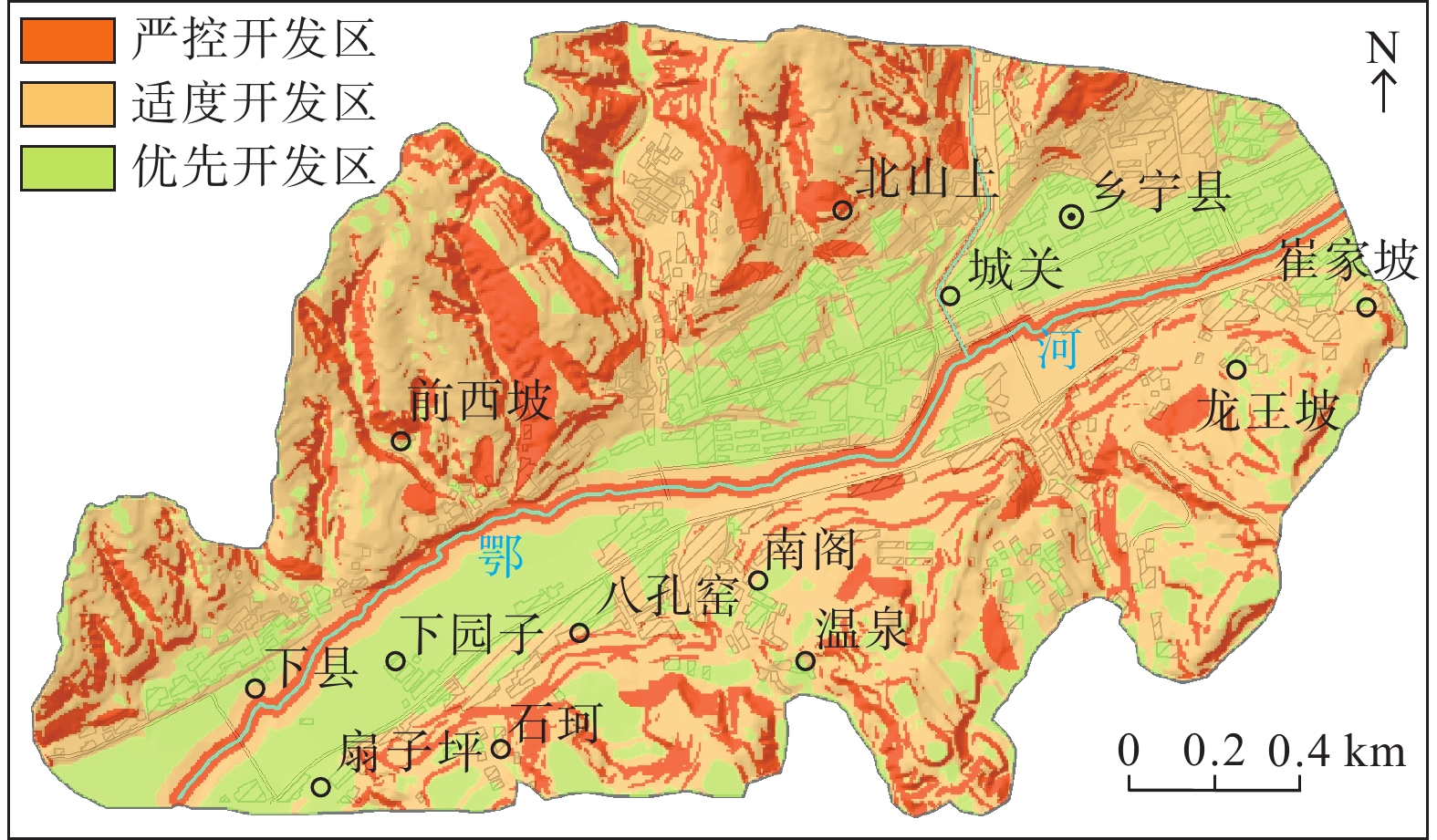A Method for Optimizing Territorial Space Planning of Mountain Towns Based on Geological Hazard Risk Assessment
-
摘要:
以山西省乡宁县城区扇子坪–崔家坡段为例,将“木桶效应”理论与地质灾害风险“点面双控”体系相结合,提出了一种基于地质灾害风险评价的国土空间规划优化方法。该方法以1∶1万地质灾害风险评价为基础,结合地质灾害风险“点面双控”体系,将坡度、河流距、地质灾害风险分区以及地质灾害隐患点致灾范围作为“木桶效应”中的短板因子,按照等级从高到低依次为严控开发区、适度开发区和优先开发区的先后顺序进行分级赋值,将同一地块内各短板因子的最高等级值作为该地块的国土空间规划优化结果值。结果表明,研究区内的严控开发区占比26.67%,适度开发区占比54.81%,优先开发区占比18.52%,从理论上说明了研究区以优先开发区和适度开发区为主,具有较大的开发潜力。文中提出的优化方法能够便捷高效地完成大比例尺山区城镇国土空间规划,研究成果可为类似地区开展国土空间规划提供参考依据。
Abstract:Taking Fanziping–Cuijiapo section of Xiangning County, Shanxi Province as an example, a method of optimizing territorial spatial planning based on geological hazard risk assessment is proposed by combining “barrel effect” theory with “double–control of point and zone” system of geological disaster risk. This method is based on 1∶10,000 geological disaster risk assessment and combined with “double–control of point and zone” system of geological disaster risk, taking slope, river distance, geological disaster risk zoning and disaster range of geological disaster hidden danger point as the short board factors in the barrel effect. According to the order of strictly controlled development zone, moderate development zone and priority development zone from high to low, the highest grade value of each weakness factor in the same plot is taken as the result value of optimizing
territorial space planning of the plot. The results show that strictly controlled development zones in the study area account for 26.67%, moderate development zones account for 54.81%, and priority development zones account for 18.52%. Theoretically, it shows that the study area is dominated by priority development zones and moderate development zones, which has great development potential. The proposed optimization method can conveniently and effectively complete territorial space planning in large scale mountainous areas, and the research results can provide a reference for similar areas to carry out territorial space planning.
-

-
图 1 承灾体与滑塌源区的距离示意图(据Hungr,2005修改)
Figure 1.
表 1 短板因子取值统计表
Table 1. Short board factors value statistical table
序号 短板因子 分级条件 优化分区 1 坡度 >35° 严控开发区 10°~35° 适度开发区 其他 优先开发区 2 河流距 干流缓冲区<50 m或
支流缓冲区<20 m严控开发区 干流缓冲区介于50~300 m或
支流缓冲区介于20~100 m优先开发区 其他 适度开发区 3 地质灾害
风险分区极高、高风险区 严控开发区 中风险区 适度开发区 低风险区 优先开发区 4 地质灾害
隐患点致
灾范围ψ角之内(灾害发生后滑塌体必然到达的最远区域) 严控开发区 ψ角之外α角之内(灾害发生后滑塌体必然到达的最远距离与灾害发生后滑塌体可能到达的最远距离之间的区域) 适度开发区 α角之外(其他区域) 优先开发区 -
[1] 陈霆, 徐伟铭, 吴升, 等. 国土空间规划视角下的城镇开发边界划定和空间管控体系构建[J]. 地球信息科学学报, 2022, 24(2): 263-279
CHEN Ting, XU Weiming, WU Sheng, et al. Delimitation of urban development boundary and construction of space control system from the perspective of territorial spatial planning[J]. Journal of Geo-information Science, 2022, 24(2): 263-279.
[2] 高晓路, 吴丹贤, 周侃, 等. 国土空间规划中城镇空间和城镇开发边界的划定[J]. 地理研究, 2019, 38(10): 2458-2472
GAO Xiaolu, WU Danxian, ZHOU Kan, et al. The urban space and urban development boundary under the framework of territory spatial planning[J]. Geographical Research, 2019, 38(10): 2458-2472.
[3] 江思义, 吴福, 刘庆超, 等. 岩溶地区建设用地地质环境适宜性评价——以广西桂林规划中心城区为例[J]. 中国地质灾害与防治学报, 2019, 30(06): 84-93
JIANG Siyi, WU Fu, LIU Qingchao, et al. Suitability evaluation of construction land development in karst area: taking city planning center of Guilin as an example[J]. The Chinese Journal of Geological Hazard and Control, 2019, 30(06): 84-93.
[4] 马云飞, 邹芳, 徐海燕. 基于地质灾害风险评价的衡东县国土空间管制研究[J]. 地理信息世界, 2020, 27(6): 14-20
MA Yunfei, ZOU Fang, XU Haiyan. Land space control of hengdong county based on geological hazard risk assessment[J]. Geomatics World, 2020, 27(6): 14-20.
[5] 沈悦, 刘天科, 周璞. 自然生态空间用途管制理论分析及管制策略研究[J]. 中国土地科学, 2017, 31(12): 17-24 doi: 10.11994/zgtdkx.20180108.143848
SHEN Yue, LIU Tianke, ZHOU Pu. Theoretical Analysis and Strategies of Natural Ecological Space Use Control[J]. China Land Sciences, 2017, 31(12): 17-24. doi: 10.11994/zgtdkx.20180108.143848
[6] 汤国安, 杨昕. ArcGIS地理信息系统空间分析实验教程[M]. 北京: 科学出版社, 2006: 429–445
TANG Guo’an, YANG Xin. ArcGIS Geographic Information system spatial analysis experiment tutorial[M]. Beijing: Science Press, 2006: 429–445.
[7] 唐亚明, 薛强, 毕俊擘, 等. 陕北黄土崩塌灾害风险评价指标体系构建[J]. 地质通报, 2012a, 31(6): 979-988
TANG Yaming, XUE Qiang, BI Junbo, et al. The construction of factors for assessing the risk of collapse at loess slopes in northern Shaanxi Province[J]. Geological Bulletin of China, 2012a, 31(6): 979-988.
[8] 唐亚明, 薛强, 李清, 等. 黄土滑塌灾害风险分级系统研究[J]. 工程地质学报, 2012b, 20(3): 378-386
TANG Yaming, XUE Qiang, LI Qing, et al. Slope classification system for loess collapse risk assessment[J]. Journal of Engineering Geology, 2012b, 20(3): 378-386.
[9] 唐亚明, 张茂省, 李政国, 等. 国内外地质灾害风险管理对比及评述[J]. 西北地质, 2015, 48(2): 238-246
TANG Yaming, ZHANG Maosheng, LI Zhengguo, et al. Review and Comparison on Inland and Overseas Geo-hazards Risk Management[J]. Northwestern Geology, 2015, 48(2): 238-246.
[10] 唐亚明. 从全球视角看城镇化进程中的土地利用模式[J]. 中国土地, 2016, 360(1): 47-48
TANG Yaming. Land use patterns in the process of urbanization from a global perspective[J]. China Land, 2016, 360(1): 47-48.
[11] 铁永波, 徐伟, 向炳霖, 等. 西南地区地质灾害风险“点面双控”体系构建与思考[J]. 中国地质灾害与防治学报, 2022, 33(3): 106-113
TIE Yongbo, XU Wei, XIANG Binglin, et al. The thoughts on construction of “double-control of point and zone” system of geological hazard risk in southwest China[J]. The Chinese Journal of Geological Hazard and Control, 2022, 33(3): 106-113.
[12] 张茂省, 刘江, 董英, 等. 国土空间优化中的关键地质要素分析与“双评价”方法[J]. 地学前缘, 2020, 27(04): 311-321
ZHANG Maosheng, LIU Jiang, DONG Ying, et al. Analysis of key geological factors and the “dual evaluation” method for land space optimization[J]. Earth Science Frontiers, 2020, 27(04): 311-321.
[13] 张晓玲, 吕晓. 国土空间用途管制的改革逻辑及其规划响应路径[J]. 自然资源学报, 2020, 35(6): 1261-1272 doi: 10.31497/zrzyxb.20200601
ZHANG Xiaoling, LV Xiao. Reform logic of territorial space use regulation and the response path of land spatial planning[J]. Journal of Natural Resources, 2020, 35(6): 1261-1272. doi: 10.31497/zrzyxb.20200601
[14] 郑续, 苗俊霞, 王东, 等. 黄河中上游地质灾害高发县国土空间开发适宜性评价及功能分区——以陕西省延川县为例[J]. 西北地质, 2020, 53(02): 289-297
ZHENG Xu, MIAO Junxia, WANG Dong, et al. Suitability evaluation and functional division of land space development in the high-incidence area of geological hazards in the middle and upper reaches of the yellow river: a case study of Yanchuan County, Shaanxi Province[J]. Northwestern Geology, 2020, 53(02): 289-297.
[15] 周启鸣, 刘学军. 数字地形分析[M]. 北京: 科学出版社, 2006: 52–70
ZHOU Qiming, LIU Xuejun. Digital terrain analysis[M]. Beijing: Science Press, 2006: 52–70.
[16] 周伟, 马书红. 基于木桶理论的公路交通与经济发展适应性研究[J]. 中国公路学报, 2003(03): 78-83
ZHOU Wei, MA Shuhong. Adaptability study based on the barrel theory about highway transportation and economics[J]. China Journal of Highway and Transport, 2003(03): 78-83.
[17] Hungr O, Corominas J, Eberhardt E. Estimating landslide motion mechanism, travel distance and velocity[A]. Hunger O, Fell R, Couture R. Proceedings of the International Conference on Landslide Risk Management[C]. London: Taylor and Francis, 2005: 108–115.
[18] Wei Y D, Ye X. Urbanization, urban land expansion and environmental change in China[J]. Stochastic Environmental Research & Risk Assessment, 2014, 28(4): 757-765.
-




 下载:
下载:


